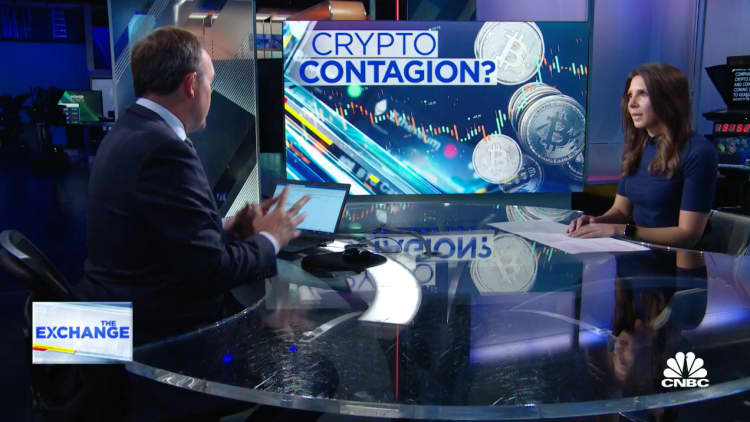Samuel Bankman-Fried’s poster in downtown San Francisco.
MacKenzie Sigalos | CNBC
The Kimchi Swap put Sam Bankman-Fried on the map.
The year was 2017, and the ex-Jane Street Capital quant trader noticed something funny when he looked at the page on CoinMarketCap.com listing the price of bitcoin on exchanges around the world. Today, that price is pretty much uniform across the exchanges, but back then, Bankman-Fried previously told CNBC that he would sometimes see a 60% difference in the value of the coin. His immediate instinct, he says, was to get in on the arbitrage trade — buying bitcoin on one exchange, selling it back on another exchange, and then earning a profit equivalent to the price spread.
related investing news
“That’s the lowest hanging fruit,” Bankman-Fried said in September.
The arbitrage opportunity was especially compelling in South Korea, where the exchange-listed price of bitcoin was significantly more than in other countries. It was dubbed the Kimchi Premium – a reference to the traditional Korean side dish of salted and fermented cabbage.

After a month of personally dabbling in the market, Bankman-Fried launched his own trading house, Alameda Research (named after his hometown of Alameda, California, near San Francisco), to scale the opportunity and work on it full-time. Bankman-Fried said in an interview in September that the firm sometimes made as much as a million dollars a day.
Part of why SBF, as he’s also called, earned street cred for carrying out a relatively straightforward trading strategy had to do with the fact that it wasn’t the easiest thing to execute on crypto rails five years ago. Bitcoin arbitrage involved setting up connections to each one of the trading platforms, as well as building out other complicated infrastructure to abstract away a lot of the operational aspects of making the trade. Bankman-Fried’s Alameda became very good at that and the money rolled in.
From there, the SBF empire ballooned.
Alameda’s success spurred the launch of crypto exchange FTX in the spring of 2019. FTX’s success begat a $2 billion venture fund that seeded other crypto firms. Bankman-Fried’s personal wealth grew to over $16 billion at its peak in March.
Bankman-Fried was suddenly the poster boy for crypto everywhere, and the FTX logo adorned everything from Formula 1 race cars to a Miami basketball arena. The 30-year-old went on an endless press tour, bragged about having a balance sheet that could one day buy Goldman Sachs, and became a fixture in Washington, where he was one of the Democratic party’s top donors, promising to sink $1 billion into U.S. political races (before later backtracking).
It was all a mirage.
As crypto prices tanked this year, Bankman-Fried bragged that he and his enterprise were immune. But in fact, the sector-wide wipeout hit his operation quite hard. Alameda borrowed money to invest in failing digital asset firms this spring and summer to keep the industry afloat, then reportedly siphoned off FTX customers’ deposits to stave off margin calls and meet immediate debt obligations. A Twitter fight with the CEO of rival exchange Binance pulled the mask off the scheme.
Alameda, FTX and a host of subsidiaries Bankman-Fried founded have filed for bankruptcy protection in Delaware. He’s stepped down from his leadership roles and lost 94% of his personal wealth in a single day. It is unclear exactly where he is now, as his $40 million Bahamas penthouse is reportedly up for sale. The photos of his face plastered across FTX advertisements throughout downtown San Francisco serve as an unwelcome reminder of his rotting empire.
It was a steep fall from hero to villain. But there were a lot of signs.
Bankman-Fried told CNBC in September that one of his fundamental principles when it comes to playing the markets is working with incomplete information.
“When you can sort of start to quantify and map out what’s going on, but you know there are a lot of things you don’t know,” he said. “You know you’re being approximate, but you have to try to figure out what trade to do anyway.”
The following account is based on reporting from CNBC, Bloomberg, the New York Times, the Wall Street Journal, and elsewhere. Piecing together bits and pieces from various news sources paints a picture of an investor who over-extended himself, frantically moved to cover his mistakes with questionable and perhaps illegal tactics, and surrounded himself with a tight cabal of advisors who could not or would not curb his worst impulses.
What went wrong in the last year
At some point in the last two years, according to reports, Alameda began borrowing money for various purposes, including to make venture investments.
Six months ago, a wave of titans in the crypto sector folded as depressed token prices sucked liquidity out of the market. First came the spectacular failure of a popular U.S. dollar-pegged stablecoin project — the stablecoin known as terraUSD (or UST, for short) and its sister token luna — wiping out $60 billion. That collapse helped to bring down Three Arrows Capital, or 3AC, which was one of the industry’s most respected crypto hedge funds. Crypto brokers and lenders like Voyager Digital and Celsius had significant exposure to 3AC, so they fell right along with it in quick succession.

The big problem was that everyone was borrowing from one another, which only works when the price of all those crypto coins keeps going up. By June, bitcoin and ether had both tumbled by more than half for the year.
“Leverage is the source of every implosion in financial institutions, both traditional and crypto,” said Hart Lambur, a former Goldman Sachs government bond trader who provided liquidity in U.S. Treasuries for central banks, money managers and hedge funds.
“Lehman Brothers, Bear Stearns, Long-Term Capital, Three Arrows Capital and now FTX all blew up due to bad leverage that got sniffed out and exploited by the market,” continued Lambur, who now works in decentralized finance.
As the dominoes fell, SBF jumped into the mix in June to try to bail out some of the failing crypto firms before it was too late, extending hundreds of millions of dollars in financing. In some cases, he made moves to try to buy these companies at fire-sale prices.
Amid the wave of bankruptcies, some of Alameda’s lenders asked for their money back. But Alameda didn’t have it, because it was no longer liquid. Bankman-Fried’s trading firm had parked the borrowed money in venture investments, a decision he told the Times was “probably not really worth it.”
To meet its debt obligations, FTX borrowed from customer deposits in FTX to quietly bail out Alameda, the Journal and the Times reported. The borrowing was in the billions. Bankman-Fried admitted the move in his interview with the Times, saying that Alameda had a large “margin position” on FTX, but he declined to disclose the exact amount.
“It was substantially larger than I had thought it was,” Bankman-Fried told the Times. “And in fact the downside risk was very significant.”
Reuters and the Journal both reported that the lifeline was around $10 billion, and Reuters reports that $1 billion to $2 billion of that emergency financing is now missing. Tapping customer funds without permission was a violation of FTX’s own terms and conditions. On Wall Street, it would be a clear violation of U.S. securities laws.
The two firms – one of the world’s biggest crypto brokers and one of the world’s biggest crypto buyers – were supposed to be separated by a firewall. But they were, in fact, quite cozy, at one point extending to a romantic relationship between Bankman-Fried and Alameda CEO Caroline Ellison, he acknowledged to the Times.
“FTX and Alameda had an extremely problematic relationship,” Castle Island Venture’s Nic Carter told CNBC. “Bankman-Fried operated both an exchange and a prop shop, which is super unorthodox and just not really allowed in actually regulated capital markets.”
The borrowing and lending scheme between the two firms was more convoluted than just using customer funds to make up for bad trading bets. FTX tried to paper over the hole by denoting assets in two crypto tokens that were essentially made up – FTT, a token created by FTX, and Serum, which was a token created and promoted by FTX and Alameda, according to financial filings reported by Bloomberg’s Matt Levine.
Firms make up crypto tokens all the time – indeed, it’s a big part of how the crypto boom of the last two years was financed – and they usually offer some sort of benefit to users, although their real value to most traders is simple speculation, that is, the hope that the price will rise. Owners of FTT were promised lower trading costs on FTX and the ability to earn interest and rewards like waived blockchain fees. While investors can profit when FTT and other coins increase in value, they’re largely unregulated and are particularly susceptible to market downturns.
These tokens were essentially proxies for what people believed Bankman-Fried’s exchange to be worth, since it controlled the vast majority of them. Investor confidence in FTX was reflected in the price of FTT.
The key point here is that FTX was reportedly siphoning off customer assets as collateral for loans, and then covering it with a token it made up and printed at will, drip-feeding only a fraction of its supply into the open market. The financial acrobatics between the two firms somewhat resembles the moves that sunk energy firm Enron almost two decades ago – in that case, Enron essentially hid losses by transferring underperforming assets to off-balance sheet subsidiaries, then created complicated financial instruments to obscure the moves.
As all this was happening, Bankman-Fried continued his press tour, lionized as one of the great young tech entrepreneurs of the age. It only began to unravel once Bankman-Fried got into a public spat with Binance, a rival…
Read More:How Sam Bankman-Fried’s FTX-Alameda empire vanished overnight
2022-11-15 23:23:45


